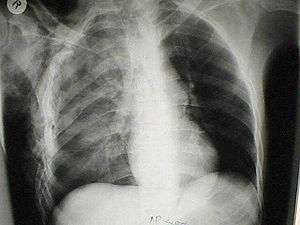Chest injury
| Chest injury | |
|---|---|
|
A chest X-ray of a right sided pulmonary contusion associated with flail chest and subcutaneous emphysema | |
| Classification and external resources | |
| Specialty | emergency medicine |
| ICD-10 | S20—S29 |
| ICD-9-CM | 959.11 |
| MeSH | D013898 |
A chest injury is any form of physical injury to the chest including the ribs, heart and lungs. Chest injuries account for 25% of all deaths from traumatic injury.[1] Typically chest injuries are caused by blunt mechanisms such as motor vehicle collisions or penetrating mechanisms such as stabbings.[2]
Classification
Chest injuries can be classified as blunt or penetrating. Blunt and penetrating injuries have different pathophysiologies and clinical courses.
Specific types of injuries include:
- Injuries to the chest wall
- Chest wall contusions or hematomas.
- Rib fractures
- Flail chest
- Sternal fractures
- Fractures of the shoulder girdle
- Pulmonary injury (injury to the lung) and injuries involving the pleural space
- Injury to the airways
- Cardiac injury
- Blood vessel injuries
- And injuries to other structures within the torso
- Esophageal injury (Boerhaave syndrome)
- Diaphragm injury
Diagnosis
Most blunt injuries are managed with relatively simple interventions like tracheal intubation and mechanical ventilation and chest tube insertion. Diagnosis of blunt injuries may be more difficult and require additional investigations such as CT scanning. Penetrating injuries often require surgery, and complex investigations are usually not needed to come to a diagnosis. Patients with penetrating trauma may deteriorate rapidly, but may also recover much faster than patients with blunt injury.
See also
Transmediastinal gunshot wound
References
Bibliography
- Feliciano, David V.; Mattox, Kenneth L.; Moore, Ernest J (2012). Trauma, Seventh Edition (Trauma (Moore)). McGraw-Hill Professional. ISBN 0-07-166351-7.
- Andrew B., MD Peitzman; Andrew B. Peitzman; Michael, MD Sabom; Donald M., MD Yearly; Timothy C., MD Fabian (2002). The trauma manual. Hagerstwon, MD: Lippincott Williams & Wilkins. ISBN 0-7817-2641-7.
